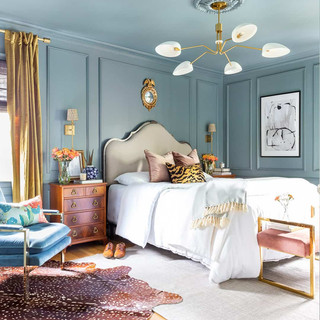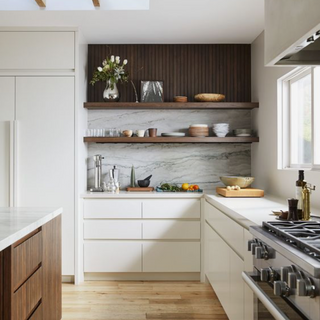2021 Interior Trends
- Tiger Oak Designs
- Jan 7, 2021
- 5 min read
Updated: Jan 12, 2021
As we emerge from the dissonance that was 2020, the way we live in our homes may have fundamentally changed. Americans spent the better part of last year sheltering in place. What once was a living room suddenly became an office, a school, a gym ... Cautiously dipping our toes into 2021, we have a better sense of appreciation for the role the home plays in our lives, and that will no-doubt be reflected in the trends that develop. The way I think about trends is not a "this is in, so that is out" approach. I still believe that if you love it, do it. These are just a few of the ways the trend-winds are blowing this year ...
1) Personalization + Self Expression
This one is my favorite. A core principle at Tiger Oak is that every space is designed for the unique family that lives in it. I preach it all the time: the opinion of your mother, sister, neighbor or friend does not matter here. Consider this scenario that plays out all the time: Jack and Jill ask their realtor to find them their "forever home." They buy it. Jack and Jill push back against their designer because they're concerned about "resale value" ... Doesn't make sense, does it? It seems as though the self-isolation we have been living in is finally giving people the freedom and self-confidence to design their spaces for the way they want to live ... because no one is coming over anyway! If you're a little bit funky, then be funky! If you've always wanted a dark living room, but your MIL thinks in will make the room look too small, PAINT THE DANG ROOM! Our homes have never been a refuge like they have been this past year. If it doesn't feel right, it's probably because it was designed with someone else in mind. Mix the styles, follow the little voice in your head, and design a home that is personal to you.
2) Rich, Bold Colors
In a world where we were constantly bombarded by color and noise, hustle and bustle, white-washed homes were welcoming. However, when you start spending more time in the home then out of it, that monotone interior can quickly become sterile and cold. This year, we are going to see bold, warm, saturated colors replacing the greige and white that dominated the past decade. Painting your boring walls with bold, moody colors will infuse some flair and personality into your home for very little cost. The resurgence of the family road-trip shows that when under stress, people find reconnecting with Mother Nature to be calming and restorative. Earth-tones do just that inside the home - they invite the outside in. If you want to learn more about the trending colors for 2021, you can find that in my blog post here.
3) Sustainable Design
The rise of sustainability-focused business practices, as well as government and social media campaigns, has pushed eco-friendly design to the forefront. Now more than ever, we are aware of the impact our consumerism is having on our planet and people want to make changes, especially when it comes to designing our homes. Sustainable choices allow us to reduce our ecological footprint while still incorporating the principles of design. (Check out this website to measure your own ecological footprint.)
Windows - Natural light is one of the best ways to reduce your energy costs. Not only do you need to use less artificial light, but you are also lowering your heating and cooling bills.
Bamboo Flooring - Bamboo is one of the fastest growing plants in the world, allowing it to be used within 4 years of planting, vs the 40-60+ years it takes to grow and harvest a tree. It also requires little pesticides, making it even better for the environment.
Recycled Materials - There are so many options to chose from when it comes to recycled materials. Reclaimed wood is an obvious one, but even big box retailers are jumping on the bandwagon, with Crate + Barrel and Pottery Barn offering a line of recycled furnishings. A favorite tile company of mine is Fireclay Tile, which sources all of their raw and recyclable materials locally and at the very least, from within the USA. My favorite recycled material at the moment is terrazzo. Famously used on the Hollywood Walk of Fame, terrazzo has seen a resurgence and now features various materials including glass, granite, quartz and marble. It can be set in cement or epoxy and has zero VOCs. It is also non-porous and antimicrobial, which helps to maintain a mold-free environment that improves air quality.
Jute/Cotton/Wool - Jute is a strong, coarse material that grows quickly and is rapidly renewable. A rain-fed plant, jute requires little to no chemical fertilizers. Not only are jute rugs durable and affordable, but they are also a good heat insulator, making them an economical option as well. Cotton is sustainable, rapidly renewable and biodegradable, making it an excellent choice throughout its life-cycle. Wool, one of the oldest used fibers, is also renewable, biodegradable and recyclable. It is highly durable with inherent flame-resistant properties, which means it doesn't require additional chemicals. It also naturally repels water. For the animal-conscious shopper, there are also traceability and animal welfare standards. Both wool and cotton can be made organically.
Shop Vintage! - The easiest way to lower your footprint is to buy something that is being discarded. Even recycling requires some sort of production, but buying used goods is the greenest of green! There are so many incredible antique shops throughout the country, especially if you can make your way to a bigger city where there is a higher likelihood of finding a hidden treasure.
4) Feel-Good Fabrics
If you haven't noticed, boucle is EVERYWHERE! Fabrics that are cozy and inviting are what we are craving right now. Mohair sofas, velvet pillows and trims, embroidery, boucle furniture ... all these fabrics encourage the cocoon-like atmosphere that people are look for.
5) Integrated Hardware
The current hardware trend seems to be steering away from big, chunky bin pulls and moving toward more streamlined, integrated or even non-existent hardware. Finger pulls are sleek way to add hardware without taking away from the look of your cabinetry. They are most often seen on European-style, flat panel cabinets, they are low profile and attach to the top or side of your cabinetry. Flush mount or recessed hardware is just as it sounds: hardware that is recessed into the front of the cabinetry, making it flush with the surface. Often seen on pocket doors, they are showing up more and more often on cabinetry, providing a less intrusive hardware option. Hardware-less cabinetry is not the same as just not putting hardware on your cabinets. Over time, that will cause the finish to wear away from peoples fingers trying to constantly open the doors. In actuality, hardware-less cabinets are bevel cut at the opening edge of a drawer or door, allowing the homeowner to open and close with their fingertips, without damaging the finishes.
I hope you have found these trends helpful, and are looking forward to ushering in the new year with a newfound confidence. Your home has so much potential, but it takes thoughtful design to make sure it is both practical and beautiful. For more information on how you can get started, visit the contact us page on our website!
xx- Natalie
"When your home shows up well for you, you can show up well for others."




































Thank you for your insight on how we can improve the comfort levels in our homes during these unusual times. You’ve shared many great, doable suggestions to keep our homes comfortable and us emotionally healthy during this time of restriction. Thanks!